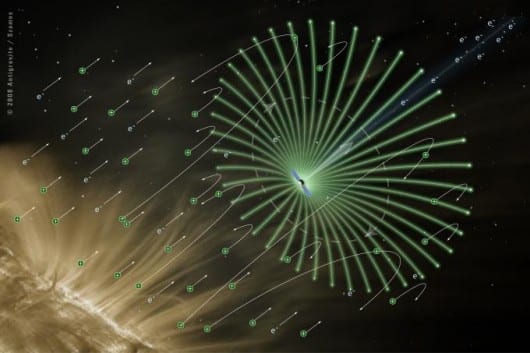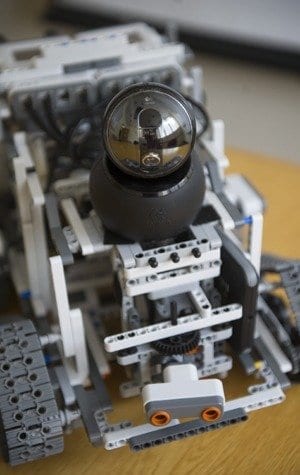
This month, the University of Helsinki and the European Space Agency (ESA) will test a new space tether that has less chance of snapping under the stresses of operating in orbit.
Installed aboard Estonia’s ESTCube-1 cubesat, the new tether is scheduled to be launched with ESA’s Proba-V satellite atop a Vega rocket as part of an experiment in developing an electric solar sail.
Tethers have been around since the United States’ Gemini 11 deployed one in 1966 to help control the capsule’s rotation. These tethers are routinely used to despin satellites by playing out weights from a spinning spacecraft. As the weights move further away, the satellite’s rotation slows down. When the spin rate is suitably slow or stopped, the tethers are released in an outer space version of “crack the whip” and the spin energy is carried off by the weights.
However, tethers have much greater potentials than just despinning satellites. They also hold the promise of allowing spacecraft to lower sensor packs from orbit into the Earth’s outer atmosphere, generate electricity by acting as an armature as they moves through the Earth’s magnetic sphere and even providing propulsion in the form of an electric solar sail.
The problem is, space tethers are a formidable engineering challenge. They need to be thin, light and flexible in order to fit inside of a spacecraft or launch vehicle, they need to be extremely long, they need to be strong enough to support a payload as well as their own weight, and, if they must transmit power or data, they need to maintain internal integrity. In other words, it doesn’t help if the tether doesn’t break if the electric wire inside snaps. At the moment, experimental tethers haven’t had a great track record. About half fail to deploy, snap or are broken by micrometeoroids.
Researchers at the University of Helsinki believe that they’ve come a step closer to a solution with a new tether that is about half the diameter of a human hair. The 50-micrometer aluminum tether has a smaller 25-micrometer wire woven into it. The clever bit is that the Helsinki team used ultrasonic welding techniques from the microelectronics industry to cross connect several wires together every centimeter. These “subwires” allow electricity to flow through the wire even if the tether stretches, causing the wires to break. If only one subwire remains intact, the current still flows.
The Latest Bing News on:
Space tether
- Tether slams Deutsche Bank over suggestion its stablecoin could failon May 9, 2024 at 4:59 pm
Stablecoin giant Tether has slammed Deutsche Bank over a newly released ... Source: Deutsche Bank The analysts concluded that most of the pegged assets in the crypto space will experience significant ...
- Tether Boosts Crypto Payments in Eastern Europe with Investment in CityPay.ioon May 8, 2024 at 9:43 pm
Tether, the USDT stablecoin issuer, disclosed its plans to expand its presence in Eastern Europe through further investment in CityPay.io.
- Bitcoin, Ethereum and Tether Price Predictions: Are Cryptocurrencies Making a Quiet Comeback?on May 8, 2024 at 3:32 pm
Cryptocurrency price predictions have improved after a rocky couple of years, but they might not exceed the lofty expectations of the past.
- USDT/TRY - Tether USDt Turkish Liraon May 8, 2024 at 11:07 am
Tether serves as the first digital asset used by most crypto investors in interfacing with the crypto space. Tether can be bought from most crypto exchanges in the blockchain ecosystem.
- USDT/BRL - Tether USDt Brazil Realon May 8, 2024 at 4:25 am
Tether serves as the first digital asset used by most crypto investors in interfacing with the crypto space. Tether can be bought from most crypto exchanges in the blockchain ecosystem.
- Bitfinex’s Tether CEO Denies Cyberattack Amidst F Society Ransom Demandson May 5, 2024 at 2:30 pm
In the midst of claims by a ransomware group known as F Society, who allege to have infiltrated Bitfinex and extracted 2.5 terabytes of data, including personal details of around 400,000 users, top ...
- Implications Of Tether’s Record Profits For The Crypto Marketon May 5, 2024 at 11:29 am
Also of note is the $1 billion that Tether generated from operating profits derived from U.S. Treasury holdings. In an interesting development, it would seem that higher-for-longer rates continue to ...
- Stablecoin Tether steps up monitoring in bid to combat illicit financeon May 3, 2024 at 2:23 pm
The world's largest stablecoin, Tether, has stepped up monitoring of how its tokens are used in broader crypto markets and payments in a bid to combat illicit finance, Tether said in a statement on ...
- Tether’s Business Profits Soar to Record-Breaking $4.52 Billion in Q1 2024, Setting New Industry Standardson May 3, 2024 at 3:17 am
Tether's business profits surged to a record-breaking $4.52 billion in Q1 2024, making it one of the company's biggest ever.
- Tether Adds Chainalysis to Boost Compliance, Monitor Digital Asset Tradingon May 2, 2024 at 1:34 pm
Top stablecoin issuer Tether will be working with Chainalysis in an effort to boost compliance and monitoring of any potential illicit activity.
The Latest Google Headlines on:
Space tether
[google_news title=”” keyword=”space tether” num_posts=”10″ blurb_length=”0″ show_thumb=”left”] [/vc_column_text]The Latest Bing News on:
Solar sail
- Opinion: The age of the solar sail is arriving sooner than expectedon May 5, 2024 at 6:30 am
NASA has launched the latest attempt to test solar sail propulsion technology.
- One step closer to a sci-fi reality—NASA announces funding for a quantum dot solar sail and a levitating train on the Moonon May 3, 2024 at 8:22 am
Other potential projects set to receive additional funding include a pulsed plasma rocket, a "fluidic telescope" designed to be a space-based optical observatory, and a radioisotope thermoradiative cell power generator. I only know what some of those words mean, but boy am I excited by all the whizz-bang imagery it creates in my head.
The Latest Google Headlines on:
Solar sail
[google_news title=”” keyword=”solar sail” num_posts=”10″ blurb_length=”0″ show_thumb=”left”]









